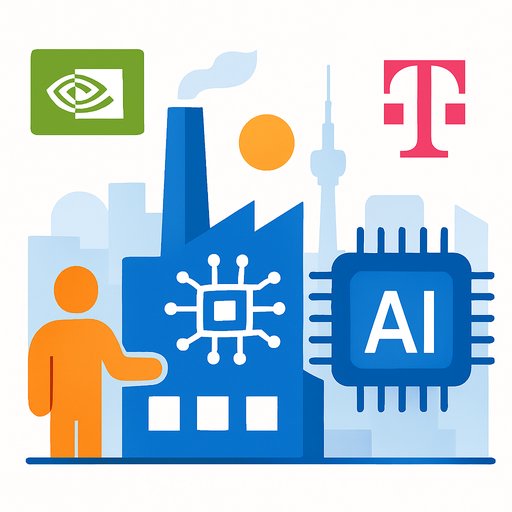Nvidia-Deutsche Telekom's €1B AI Factory: Practical Implications for Engineering and Product Teams
Germany is getting a serious compute lift. Nvidia and Deutsche Telekom are teaming up on a €1 billion "AI factory" in Munich that will boost the country's AI capacity by about 50% and keep sensitive workloads inside national borders.
For teams building LLMs, digital twins, or high-throughput inference, this matters. You'll get local access to massive GPU fleets, lower latency for German users, and infrastructure that checks the data residency box from day one.
The deal at a glance
- €1B partnership to build an "Industrial AI Cloud" in Munich
- Expected start of operations: early 2026
- Compute: 1,000+ Nvidia DGX B200 systems and RTX Pro Servers, up to 10,000 Blackwell GPUs
- Data residency: built to comply with German data sovereignty laws and GDPR
- Early partners: Agile Robots (server rack installation automation), Perplexity (in-country inference services)
- Enterprise layer: SAP Business Technology Platform and applications
The stack: Blackwell, DGX, and RTX Pro
At the core is Nvidia's Blackwell architecture, built for large-scale training and high-volume inference. Expect higher throughput, better efficiency per watt, and faster iteration for production AI setups.
If you're planning multi-billion parameter models, retrieval-augmented generation, or token-heavy inference, this setup is built for sustained load. Learn more about the Blackwell architecture.
What you can build on day one
- LLM deployment with in-country hosting and compliance
- Real-time AI inference for products that need sub-100ms responses in Germany
- Digital twins for factories, logistics, and field operations
- Physics-based simulation for engineering and materials R&D
- Edge AI pipelines with cloud coordination for fleets, devices, and on-prem sites
Why it matters for product and engineering
- Shorter cycles: faster training and inference means more experiments, quicker releases
- Compliance by default: keep industrial and customer data within Germany and the EU
- Latency wins: better UX for German users with in-country endpoints
- Vendor diversity: another serious option beyond hyperscaler-only setups
Data governance and sovereignty
The facility is built to meet German data sovereignty expectations and EU rules. That's useful if your security team pushes for in-country processing and strict audit trails. Reference point: EU data protection rules (GDPR).
Ecosystem: Deutsche Telekom, SAP, and early users
Deutsche Telekom provides the infrastructure and operations foundation. SAP brings the enterprise layer-business applications and integration through SAP BTP-so existing SAP shops can fold AI into current workflows without a rip-and-replace.
Agile Robots will automate server rack installation, a practical example of AI-enabled infrastructure work. Perplexity plans to offer "in-country" inference for German users and businesses, a strong sign of the platform's focus on local compliance and latency.
Timeline and independence from EU funding
The site targets an early 2026 launch. While the EU has discussed large-scale funding for AI infrastructure, Deutsche Telekom states this project is independent of the bloc's wider "AI gigafactory" push.
As Deutsche Telekom's CEO Tim Höttges put it: "Mechanical engineering and industry have made this country strong. But here, too, we are challenged. AI is a huge opportunity. It will help to improve our products and strengthen our European strengths."
Practical next steps for teams
- Map workloads: which services benefit most from in-country inference or high-memory GPUs?
- Plan data flows: define what must stay in Germany; document residency, retention, and access policies
- Prototype on similar SKUs: validate token costs, throughput, and QoS targets against Blackwell-class profiles
- Prep for hybrid: design network, identity, and observability to span on-prem, edge, and this cloud
- Budget early: GPU availability and reserved capacity will matter-secure slots for 2026
- Team skills: upskill on LLM ops, RAG architectures, vector databases, and scalable inference
Want structured upskilling for devs and product teams? Explore focused tracks here: AI courses by job.
FAQ
What's the main goal?
Build an "AI factory" in Munich that lifts Germany's AI compute by about 50% and provides advanced services under German data sovereignty rules.
What hardware is planned?
Over 1,000 Nvidia DGX B200 systems and RTX Pro Servers, with up to 10,000 Blackwell GPUs.
Who are the early partners?
Agile Robots (server rack installation automation) and Perplexity (in-country AI inference for German users and enterprises). SAP contributes the enterprise software layer.
What are the primary use cases?
AI inference at scale, LLM hosting, digital twins, physics-based simulation, and edge AI.
When will it go live?
Early 2026.
How does this relate to the EU's AI gigafactory plans?
It's a separate, industry-led initiative-independent of the EU program.
Why choose this over foreign infrastructure?
Lower latency for German users, local data processing for compliance, and less reliance on external providers.
Bottom line
This move gives German builders serious local compute, lower-latency endpoints, and clear paths for compliant AI products. If your roadmap depends on large models, high-throughput inference, or industrial simulation, start planning for capacity now.
Your membership also unlocks:










